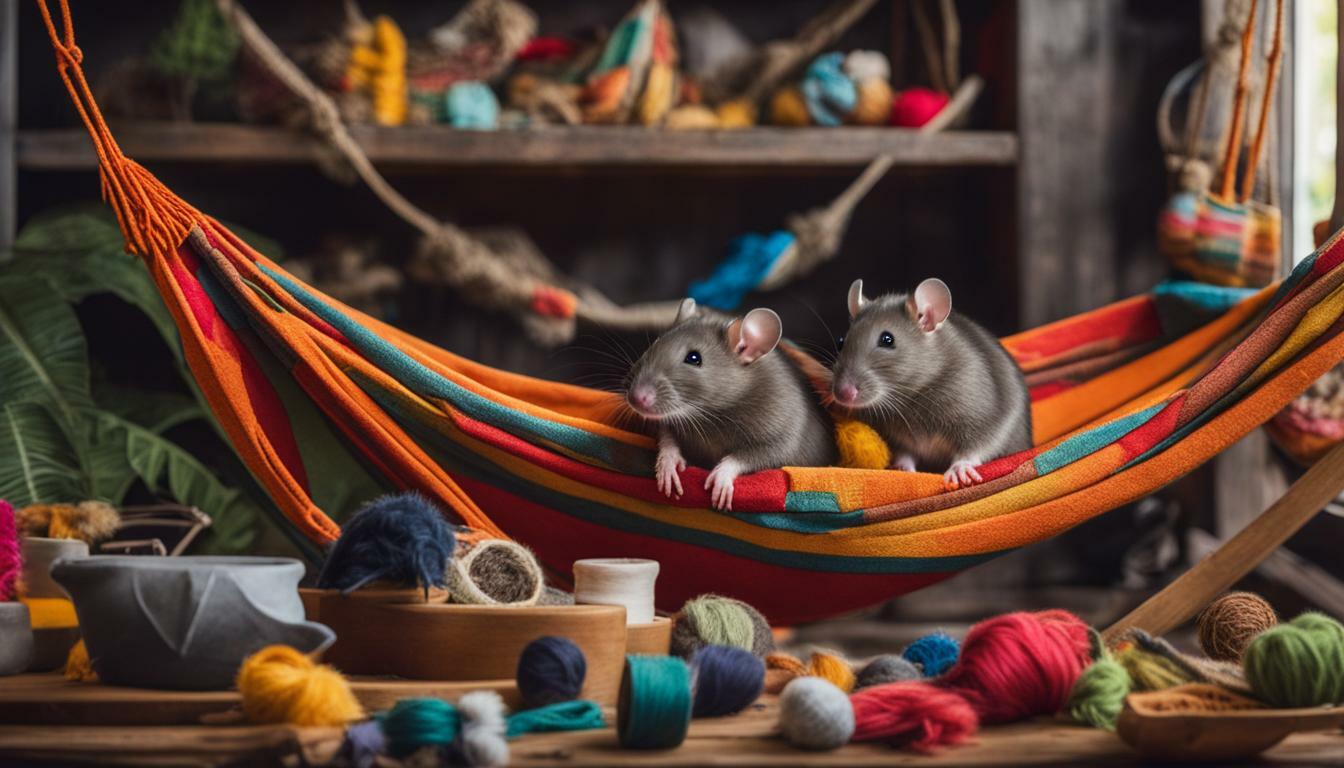Are hammocks a preferred choice for rats? Let’s delve into the fascinating world of rat behavior and preferences to find out.
Key Takeaways:
- Rats generally feel safer and more comfortable in elevated and secluded places, replicating their instinct to hide from predators in trees.
- Hammocks should be spacious enough for rats to comfortably lie on, with the option for them to sleep in a pocket if desired.
- Some rats may prefer alternative options such as hanging cubes or other types of hiding spots over hammocks.
- Introducing rats to hammocks may require time and gradual adjustments, using bridges or ladders to help them feel more comfortable.
- Previous negative experiences, such as falling out of hammocks, can make rats fearful, but strategies can be employed to help them overcome any fear or hesitancy.
- Regular maintenance and care of hammocks, including checking for holes, is essential for rat comfort and safety.
- Providing familiar toys or bedding material can help rats become more familiar and comfortable with hammocks.
Understanding rat behavior and preferences is crucial when considering hammocks as a form of enrichment for your furry companions. By providing rats with suitable hammocks, you can create a safe and cozy environment that caters to their natural instincts and enhances their well-being.
Rat Behavior and Hammocks
Rat behavior studies have revealed that hammocks provide a sense of security and enrichment for these small and curious creatures. Rats are naturally drawn to elevated and secluded spaces, mimicking their instinct to hide from predators in trees. Hammocks offer a safe and comfortable spot for rats to rest, play, and sleep, thus promoting their overall well-being.
When choosing a hammock for rats, it is important to consider their comfort and preferences. The hammock should be large enough for rats to comfortably lay on, allowing them to stretch out and relax. Additionally, providing a pocket within the hammock allows rats to curl up and feel even more secure. This design feature mimics their instinct to find cozy hiding spots in their natural habitat.
While many rats enjoy hammocks, it’s important to note that not all rats may have the same preference. Some rats may prefer alternative options such as hanging cubes or other types of hiding spots. It is essential to observe and understand your rat’s behavior to determine their preferred type of resting spot. Alternative options, like Critter Space Pods, offer additional choices for rat owners to provide comfortable habitats that suit their individual rats’ preferences.
Introducing Rats to Hammocks
Introducing rats to hammocks may take some time and patience. Some rats may be hesitant if they are not familiar with hanging objects. To help them feel more comfortable, consider adding bridges or ladders to the cage. These additions provide a gradual transition and assist rats in getting accustomed to the new hammock. Creating a familiar environment will help rats associate the hammock with comfort and security.
It’s important to address any fear or negative experiences rats may have had with hammocks in the past. For example, rats might become fearful if they have fallen out of their hammocks before. In such cases, it is crucial to ensure regular maintenance and care for the hammocks, checking the fabric for holes that could compromise rat comfort and safety. By addressing any past negative experiences and providing a safe and secure hammock, you can help your rats overcome their fears and enjoy the benefits of hammock enrichment.
In conclusion, hammocks provide rats with a sense of security, comfort, and enrichment. Understanding rat behavior and preferences is essential in selecting the right hammock and introducing it to your furry companions. Remember to offer alternative options for rats that may not prefer hammocks, and be patient as rats adjust and become familiar with their new resting spot. By providing a clean and cozy environment, you can ensure your rats’ well-being and happiness.
Finding the Right Hammock for Rats
When selecting a hammock for your rats, it’s essential to consider their comfort and preferences. Rats generally like hammocks because they feel safer and more comfortable in elevated and secluded places, replicating their instinct to hide from predators in trees. The size of the hammock is crucial, as it should be big enough for rats to comfortably lay on. Furthermore, providing a pocket within the hammock allows rats to have a cozy space to sleep in if desired.
However, it’s important to acknowledge that not all rats may prefer hammocks. Some rats may feel more at ease in hanging cubes or other types of hiding spots. It’s crucial to observe your rats’ behavior and preferences to determine the best option that suits them. Additionally, it may take time for rats to become accustomed to hammocks, especially if they are not familiar with hanging objects.
To help rats feel more comfortable with hammocks, consider adding bridges or ladders to the cage. These additional features can provide a gradual transition and assist rats in adapting to the new hammock. If rats have had negative experiences with hammocks in the past, such as falling out of them, they may develop fear or hesitancy towards using them. Regularly checking the fabric of the hammocks for holes and replacing them when necessary is crucial for rat comfort and safety.
In some cases, rats may simply not enjoy hammocks. In such instances, alternative options like Critter Space Pods can be used to provide comfortable hiding spots for your rat companions. It’s also beneficial to familiarize rats with hammocks by introducing toys or bedding made from the same material. This can help rats associate the hammock with comfort and familiarity, increasing their likelihood of using it.
| Summary |
|---|
| When selecting a hammock for rats, consider their comfort and preferences. Rats generally like hammocks because they feel safer and more comfortable in elevated and secluded places, replicating their instinct to hide from predators in trees. The size of the hammock should be spacious enough for rats to comfortably lay on, with the option of a pocket for sleeping. However, some rats may prefer hanging cubes or other hiding spots, so it’s important to observe their behavior and adapt accordingly. Introducing bridges or ladders to the cage can help rats become more comfortable with hammocks, especially if they are hesitant or unfamiliar with hanging objects. Checking the fabric regularly for holes and replacing as needed ensures rat comfort and safety. If rats do not enjoy hammocks, alternative options such as Critter Space Pods can be considered. Providing toys or bedding with the same material as the hammock can help rats become more familiar and comfortable with it. |
Alternatives to Hammocks for Rats
While many rats enjoy hammocks, it’s important to acknowledge that individual preferences may vary, and alternative options exist. Some rats may prefer hanging cubes or other types of hiding spots over hammocks. These alternatives provide a similar sense of security and comfort, catering to rats who may not be inclined towards hammocks.
Rats are highly intelligent and have unique personalities, so it is essential to consider their individual preferences when selecting their habitat. One alternative to traditional hammocks is the use of Critter Space Pods. These sturdy, enclosed structures offer rats a cozy and private space to sleep and hide. With their multiple levels and comfortable bedding, Critter Space Pods provide a variety of options for rats to explore and relax in.
If you opt for a hanging cube as an alternative to a hammock, ensure that it is made from safe and durable materials. Hang the cube securely within the cage, providing rats with a soft and comfortable space to retreat to. It’s crucial to choose a cube that is easily washable to maintain a clean and hygienic environment for your furry friends.
| Advantages of Alternatives to Hammocks: | Disadvantages of Alternatives to Hammocks: |
|---|---|
|
|
Remember, each rat is unique, and their preferences should be considered when creating their ideal living space. By providing a range of alternatives to hammocks, you can ensure that your rats have a comfortable and enriching environment that suits their individual needs.
Introducing Rats to Hammocks
If your rats are not familiar with hammocks, introducing them to these cozy hanging spots can be a gradual process. Rats, like humans, can be cautious when it comes to new things in their environment. To help your furry friends become comfortable with hammocks, consider following these tips:
1. Start with familiar bedding: Familiar scents and textures can provide a sense of security for rats. Place a piece of their favorite bedding material, such as soft fleece or shredded paper, in the hammock to make it more inviting to them.
| Tips for Introducing Rats to Hammocks |
|---|
| 2. Offer treats and rewards: |
| Give your rats tasty treats and rewards when they approach the hammock or show interest in it. Positive reinforcement will help them associate the hammock with positive experiences. |
| 3. Use bridges or ladders: |
| Place bridges or ladders leading to the hammock to create an easier path for your rats to explore. This will help them gradually become more comfortable with the idea of climbing and resting in the hammock. |
| 4. Be patient and observe: |
| Give your rats time to approach the hammock at their own pace. Observe their behavior and body language to ensure they feel safe and comfortable. If they show signs of hesitation or stress, it may be necessary to slow down the introduction process. |
Remember: Each rat is unique, and their preferences may vary. While some rats may immediately take to hammocks, others may need more time to adjust. It’s important to be patient, provide a supportive environment, and respect your rats’ individual comfort levels.
By gradually introducing rats to hammocks and creating positive associations, you can help them discover the joy of lounging and playing in these elevated hideouts. Remember to always prioritize your rats’ well-being and monitor their behavior to ensure they are comfortable and content.
Overcoming Fear and Negative Experiences
Some rats may have had negative experiences with hammocks in the past, leading to fear or hesitancy. It is important to understand that rats, like humans, can have individual preferences and reactions to different stimuli. If your rat has had a negative experience with a hammock, it may take some time and patience to help them overcome their fear and feel comfortable with it again.
One effective strategy is to gradually introduce the hammock to your rat. Start by placing it in their cage or play area without attaching it to any hooks or fixtures. Allow them to explore the hammock at their own pace, sniffing and investigating it. You can even place some treats or their favorite bedding inside to entice them.
Once your rat starts showing curiosity and interest in the hammock, you can begin the process of slowly hanging it up. Start by attaching one corner securely to the cage, ensuring that it is stable and won’t swing too much. Gradually increase the height and stability as your rat becomes more comfortable. Remember to always supervise them during this process to ensure their safety.
If your rat continues to show fear or hesitancy, consider providing alternative options. Some rats may prefer hanging cubes or other types of hiding spots instead of hammocks. Observing your rat’s behavior and preferences can help you determine what type of enrichment they enjoy the most.
| Tip: | Adding bridges or ladders to the cage can help your rat feel more comfortable with hammocks. These additional accessories provide a familiar climbing surface, making the transition to a hammock easier for your rat. |
|---|
Remember to regularly check the fabric of the hammock for any holes or signs of wear and tear. Damaged hammocks can pose a safety risk for your rat and should be replaced promptly. By ensuring the hammock is in good condition, you provide your rat with a comfortable and secure resting place.
If your rat still shows no interest in hammocks despite your efforts, don’t worry. There are alternative options available, such as Critter Space Pods. These cozy hideouts offer a safe and secluded spot for your rat to rest and play.
Some rats may have had negative experiences with hammocks in the past, leading to fear or hesitancy. It is important to understand that rats, like humans, can have individual preferences and reactions to different stimuli.
To help your rat overcome their fear and negative experiences with hammocks, remember to be patient and take things at their own pace. With time and understanding, you can help your rat feel comfortable and enjoy the benefits of a hammock as a cozy and enriching addition to their habitat.
Maintaining and Caring for Hammocks
To keep your rat hammocks in optimal condition, regular maintenance and care are essential. Rats are known for their curious and active nature, which can result in wear and tear on their hammocks over time. By following a few simple steps, you can ensure that your rat’s favorite resting spot remains comfortable and safe.
1. Check the fabric regularly
Inspect the fabric of your rat hammocks regularly for any signs of damage, such as holes or frayed edges. Rats love to chew, so it’s important to catch any small tears before they become bigger problems. If you notice any damage, replace the hammock with a new one to prevent your rat from getting tangled or injured.
2. Clean and sanitize
Rat bedding can accumulate dirt, droppings, and odors over time. It’s important to regularly clean and sanitize your rat hammocks to maintain a clean and hygienic environment for your furry friend. Follow the manufacturer’s instructions for cleaning, and make sure to use pet-safe detergents or solutions. Allow the hammock to fully dry before reattaching it to your rat’s cage.
3. Provide backup options
While most rats enjoy hammocks, some may prefer alternative options for relaxation and hiding. Consider providing hanging cubes or other types of hiding spots in addition to hammocks. This way, your rat will have a variety of choices and can decide which option they prefer. Observing your rat’s behavior will help you determine their preferences and provide them with the most comfortable environment.
By maintaining and caring for your rat hammocks, you can ensure that your furry friend remains happy and comfortable. Regularly checking the fabric for any damage, cleaning and sanitizing, and offering alternative options will contribute to a safe and enriching environment for your pet rat. Remember to observe your rat’s behavior and preferences to provide them with the best possible experience.
| Key Points: |
|---|
| Regularly check the fabric for any damage |
| Clean and sanitize the hammocks |
| Offer alternative options for your rat to choose from |
Familiarizing Rats with Hammocks
If your rats are still unsure about hammocks, there are strategies to help them become more familiar and comfortable. It’s not uncommon for rats to initially be hesitant or even fearful of new objects in their environment. However, with patience and the right approach, you can help your furry friends embrace the cozy comfort of hammocks.
One effective strategy is to introduce familiar scents and textures associated with the hammock. Consider adding bedding or toys made from the same material as the hammock inside their cage. This will help rats associate the hammock with positive experiences and familiarity. By gradually introducing these items, your rats will begin to develop positive associations with the hammock, making them more likely to explore and use it.
In addition to creating a positive association, it’s important to provide additional support structures for your rats to feel more at ease with the hammock. Adding bridges or ladders to the cage will allow your rats to climb on and off the hammock with confidence, reducing any anxiety they may have about getting in or out.
Remember that each rat is unique, and it may take some time for them to fully embrace the hammock. Be patient and provide plenty of opportunities for your rats to explore and discover the hammock on their own terms. With time and positive reinforcement, your rats will soon be enjoying the comfort and relaxation that hammocks provide.
Table: Hammock Familiarization Strategies
| Strategies | Description |
|---|---|
| Introduce familiar scents and textures | Add bedding or toys with the same material as the hammock to create positive associations. |
| Provide additional support structures | Add bridges or ladders to help rats climb on and off the hammock with confidence. |
| Be patient and allow exploration | Give rats time to investigate and familiarize themselves with the hammock at their own pace. |
| Offer treats or rewards | Encourage rats to interact with the hammock by providing rewards for positive behaviors. |
Conclusion
By understanding rat behavior and preferences, rat owners can provide their furry companions with an enriching and comfortable environment, including the option of hammocks. Rats generally enjoy hammocks because these elevated and secluded spots mimic their natural instinct to find safety and comfort in trees. When choosing a hammock for rats, it’s important to ensure it is spacious enough for them to comfortably lay on and includes a pocket for those who prefer to sleep inside.
However, it’s worth noting that not all rats may prefer hammocks. Some individuals may feel more at ease in hanging cubes or other types of hiding spots. It may take time for rats to become used to hammocks, especially if they are unfamiliar with hanging objects. To ease their transition, adding bridges or ladders to the cage can help them feel more comfortable and gradually introduce them to the new hammock.
It’s also crucial to consider any previous negative experiences rats may have had with hammocks, such as falling out of them. Such incidents can make rats fearful of using hammocks again. Regularly checking the fabric for holes is important to maintain rat comfort and safety. If rats do not enjoy hammocks, alternative options like Critter Space Pods can be explored to provide them with comfortable and cozy habitats.
To familiarize rats with hammocks, providing toys or bedding with the same material as the hammock can help establish a positive association. This can make rats feel more secure and at ease while using the hammock. By taking these measures, rat owners can ensure their furry companions have a stimulating and enjoyable environment that suits their individual preferences and needs.
FAQ
Do rats generally like hammocks?
Yes, rats generally like hammocks because they feel safer and more comfortable in a higher and secluded place, which comes from their instinct to hide from predators in trees.
What should the size of a rat hammock be?
Hammocks for rats should be big enough for them to comfortably lay on, with a pocket for them to sleep in if desired.
Are there alternative options to hammocks for rats who do not like them?
Yes, some rats may prefer hanging cubes or other types of hiding spots over hammocks. Critter Space Pods can also be used as an alternative option for rat habitats.
How can I introduce rats to hammocks if they are hesitant?
Adding bridges or ladders to the cage can help rats feel more comfortable with hammocks. It may also take time for rats to get used to hammocks if they are not familiar with hanging objects.
What should I do if my rats have had negative experiences with hammocks?
If rats have had previous negative experiences with hammocks, such as falling out of them, it is important to check the fabric of hammocks regularly for holes and replace them if necessary. Strategies to help rats overcome fear or hesitancy associated with hammocks can also be implemented.
How do I care for and maintain hammocks for rats?
It is important to check the fabric of hammocks regularly for holes and to replace them if necessary. Regular maintenance and cleaning are crucial to ensure the longevity of hammocks and provide a clean and cozy environment for rats.
How can I familiarize rats with hammocks?
Providing toys or bedding with the same material as the hammock can help rats become more familiar and comfortable with it. This helps rats associate the hammock with comfort and familiarity.




